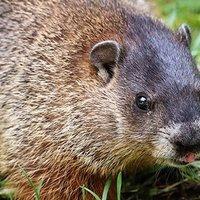Groundhogs (Marmota monax), also known as woodchucks, are very common in Southern Maine. The largest member of the squirrel family can grow to be two feet long and around ten pounds. Groundhogs are brownish gray. They have powerful front feet to dig their burrows. Groundhogs camouflage the openings to their burrows, which can be extensive. They mate in March or April in Southern Maine and give birth to two to six babies 32 days later. The young are weaned in June or July and go off to form their own burrows. Groundhogs are one of the few mammals to truly hibernate, so they do not usually cause a problem in winter. When they are awake, however, groundhogs can cause all types of problems for you.
Groundhog Problems In Southern Maine
Groundhogs eat pretty much any plant, including your garden plants. They love tomatoes and will get them before you do. They damage commercial crops such as alfalfa, soybeans, beans, squash, and tomatoes.
Most of the damage groundhogs cause is because of their extensive burrow system. The burrow is two to six feet deep and can be 40 feet in length. These borrows pose a hazard to tractors and other farm machinery, as well as horses and people. Groundhogs may put the entrance to their burrow in the crawl space under your house to hide it from predators.
Groundhogs can be aggressive and are large enough to do some real damage. They have the standard rodent teeth which are very sharp and strong. They are also vulnerable to rabies, which makes them dangerous to the people and animals they meet.
Ways To Get Rid Of Groundhogs.
The best method to get rid of groundhogs is exclusion. Make sure the crawl space is sealed so the animals cannot get underneath to burrow. Putting a fence around your garden or flower beds can also help.
- Fences should be built of a 2-inch mesh or chicken wire. They need to be at least 6 feet above the ground and go twelve inches into the ground.
- The last six inches underground should be bent into an L shape to make it hard for the groundhog to dig under it.
- Leave the top two feet of the fence unsecured to the fence posts.
- Bent it out at a 45-degree angle so the groundhog cannot get a good grip.
- Putting a single electric wire 4-5 inches in front of the fence and 4-5 inches above the ground will often stop the groundhog from climbing the fence.
Of course, fencing is only practical if you have a relatively small area to protect.
You may attempt to get the groundhog to relocate. Find all the burrow’s entrances. Stuff a rag soaked in gasoline in all of the entrances but one. Groundhogs hate the smell of gas, so will probably relocate through the open entrance. However, they may dig their new burrow on a different part of your yard.
You can live trap groundhogs.
- The trap must be at least 10x10x24 inches.
- It should be placed by the entrance to the animal’s burrow.
- Groundhogs are usually in their burrows all night.
- Put the baited live trap in front of the burrow just before dawn and remove it just after dark.
- Bait it with fruit or vegetables.
- Do not set the trap for several days so that the groundhog gets used to using it as a feeding station.
- When that happens, set the trap.
When you have caught a groundhog, you need to release it or humanely euthanize it. You cannot release a groundhog on someone’s property without their permission. Do not trap in the spring, when young may be nursing or late in the fall when they may not be able to dig a burrow before it is time for them to hibernate.
Call Big Blue Bug Solutions For Help Getting Rid Of Groundhogs
Getting rid of groundhogs is hard. Building fences, finding the burrow entrances, and live trapping the groundhog is a challenge. This is especially difficult as the groundhog may behave aggressively toward you when trapped. Big Blue Bug Solutions can take care of the groundhogs for you. They are licensed to provide wildlife pest control solutions in Southern Maine and surrounding areas. Big Blue Bug Solutions will perform a free inspection, then tell you what they can do to fix your groundhog problem. Contact Big Blue Bug Solutions today at (888) 411-5699 to get rid of your groundhog problem.

